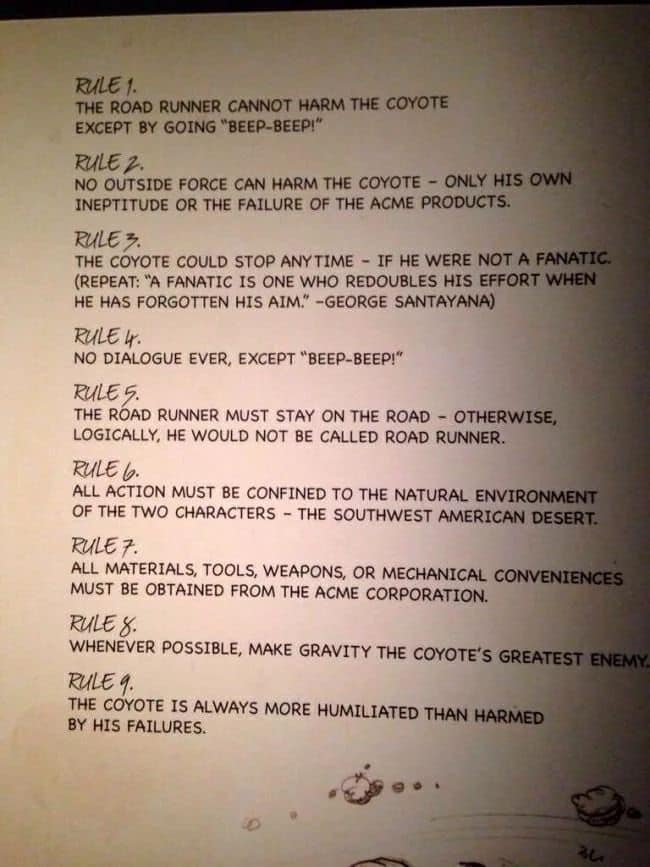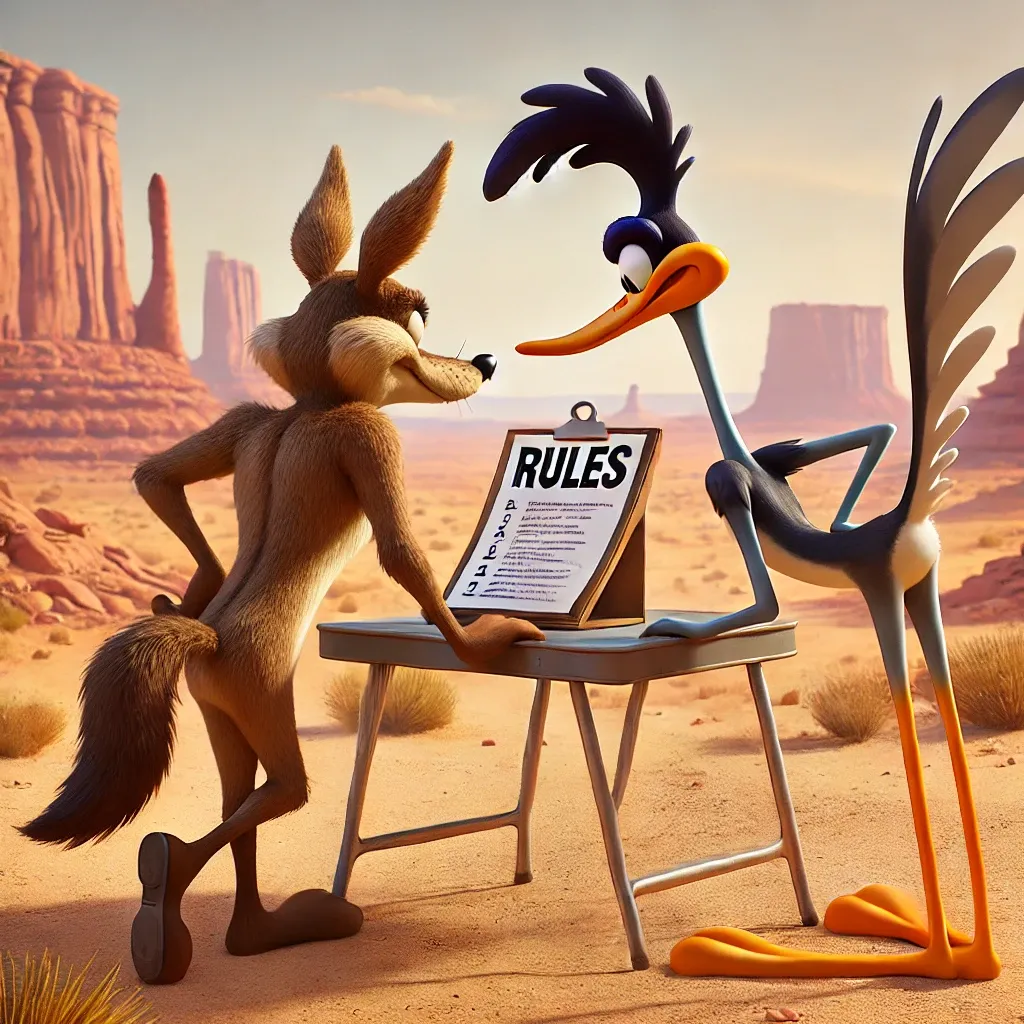Alternative title: "How To Produce One-Page Content Guidelines That People Actually Read"
I was mindlessly scrolling for a minute this afternoon and spotted this picture making the rounds on Facebook and Reddit (/r/coolguides).
Supposedly, it's a list of rules for every Looney Tunes episode of Wile E. Coyote and the Road Runner.

Here is the text version:
Rule 1. The Road Runner cannot harm the Coyote except by going “beep-beep!”
Rule 2. No outside force can harm the Coyote—only his own ineptitude or the failure of the Acme products.
Rule 3. The Coyote could stop anytime—if he were not a fanatic. (Repeat: “A fanatic is one who redoubles his effort when he has forgotten his aim.” —George Santayana.)
Rule 4. No dialogue ever, except “beep-beep!”
Rule 5. The Road Runner must stay on the road—otherwise, logically, he would not be called Road Runner.
Rule 6. All action must be confined to the natural environment of the two characters—the Southwest American desert.
Rule 7. All materials, tools, weapons, or mechanical conveniences must be obtained from the Acme Corporation.
Rule 8. Whenever possible, make gravity the Coyote’s greatest enemy.
Rule 9. The Coyote is always more humiliated than harmed by his failures.
For this article we don't care when the document was written. 😉
This document is what your editorial guidelines should look like if you actually want people to read them.
Guidelines or Guardrails?
It is tempting to build a 34-page editorial guidelines document, filled with examples for everyone to follow. I have done it for clients.
Here on the Content Harmony blog our post on how to create editorial guidelines even advises to 'go as deep as possible'. I have been tempted to do it for Content Harmony, although we kept our published editorial guidelines short and readable.
But even if you create that 34-page document, in the end, not enough team members will read it and internalize everything it has to share. And it's a pain to keep it up-to-date.
It might be the final source of truth, but maybe it's not the document you should send to new writers and team members?
Instead...
What are the 9 rules to producing content for your brand?
What are the 5 things that a writer must always do in every content asset your team publishes?
It's not about how we handle bullets and blockquotes - it's about what makes the content ours.
Those are the most essential pieces of information to put in front of new team members.
In reality, a single page guide like this Wile E. Coyote and the Road Runner example will be way more read and digested - which probably means it's wildly more effective.
Fixed Principles, Flexible Execution
Look at the language used in these rules: cannot, only, no dialogue ever, no outside force, must, all action must, all materials etc must, whenever possible, always.
These are inviolable, immutable, unchanging directives. It clearly lays out parameters for writers to successfully write an episode of Wile E. Coyote and the Road Runner even if Chuck Jones and his team weren't in the room.
Nearly half of the rules focus on the physics of the coyote & road runner's universe.
Your goal for your brand should be to make your editorial guidelines this clear.
They need to be this grounded and principled and embedded in the story you want to tell.
These constraints aren't telling the writers how to be funny. They're just establishing Wile E. Coyote & Road Runner's relationship and the "rules" of their universe.
Your guidelines shouldn't tell your writers how to be smart or insightful. They should be establishing your brand's relationship with its customers and the "physics" of your brand's universe.

Example Content Rules in Practice
Since I'm not aware of any brands that have done this in reality, let's look at some examples I made up.
Content Rules for Content Harmony
Here is an example I have built for Content Harmony. It's not official, but it's a decent first draft of where I might take this:
Rule 1. We exist to help content marketers be more effective. All of our content must support that.
Rule 2. Show, don't tell. Every article must have examples that readers can copy, either real or made up for that piece.
Rule 3. Sometimes it's hard to find examples you can publish publicly. In that case, don't skip it, make your own. Then let the reader download a copy of what you built.
Rule 4. Never assume knowledge. Define terms on first use.
Rule 5. Always include screenshots, examples, or mockups.
Rule 6. Write like you're helping a friend. Cut back on marketing jargon or buzzwords.
Rule 7. Every piece needs one surprising insight. What can we contribute to the topic that nobody else has?
Rule 8. Focus on one problem at a time. Solve it completely.
Rule 9. End with a clear next step. Readers should know exactly what to do when they finish reading.
Content Rules for REI
Here is an example of a direction you might go if you're REI (again, these aren't official, I made them up):
Rule 1. All gear reviews must include testing in real conditions. No lab-only or theoretical reviews.
Rule 2. Nature always appears untouched. No staged campfires, moved rocks, or manufactured scenes.
Rule 3. Every how-to guide must work for both beginners and experts. No assuming experience level.
Rule 4. People in photos must follow actual safety practices. No compromising safety for style.
Rule 5. We always respect nature. No ignoring sustainability.
Rule 6. All writers must have real world experience in their topic.
Rule 7. Include specific locations and conditions. No generic "great for hiking" claims.
Rule 8. Show a spectrum of outdoor participants. No defaulting to any single group or skill level.
Rule 9. We exist to inspire and equip everyone to get outside. Our content should always do this as well.
Questions To Get You Started
Here's a set of grouped questions you can use as a brainstorming guide as you build your own:
Core Identity Questions:
- What would make a piece of content instantly recognizable as NOT your brand?
- What do you refuse to compromise on, even when it would be easier?
- What are your "physics" - the fundamental laws that govern how your brand operates?
- What do competitors do that you would never do?
- What practices do you consider "cheating" in your industry?
Content Creation Questions:
- What makes your audience immediately trust a piece of content?
- What makes them immediately distrust it?
- What must appear in every single piece?
- What can never appear?
- What tone mistakes would stand out as jarring to regular readers?
- What formatting or structural elements must stay consistent?
- What sources or types of evidence do you consider valid?
- What sources or types of evidence are forbidden?
Visual Questions:
- What must all imagery include?
- What can never appear in images?
- What angles, compositions, or styles are forbidden?
- What colors or visual elements must stay consistent?
- What visual clichés in your industry do you reject?
Voice Questions:
- What words or phrases are forbidden?
- What industry jargon do you embrace vs reject?
- What reading level do you target?
- What assumptions about the reader are never allowed?
- What tone elements must stay consistent?
Process Questions:
- What steps in creation are unskippable?
- What shortcuts are never allowed?
- What must be verified before publishing?
- What level of evidence is required for claims?
- What types of examples must be included?
Audience Questions:
- Who are we always speaking to?
- What questions must every piece answer for the reader?
- What promised value must every piece deliver?
- What audience pain points must you acknowledge?
- What audience expertise level do you assume/not assume?
- What actions should readers always be able to take after consuming your content?
Mission Alignment:
- How must each piece advance your larger mission?
- What principles can never be sacrificed for engagement?
- What industry myths are you committed to fighting?
- What truths must you always tell, even when uncomfortable?
- What positive change must each piece drive toward?
Distribution Questions:
- What contexts must your content work within?
- What platforms or formats are forbidden?
- What presentation elements must stay consistent across channels?
- What types of promotion are never allowed?
Ethical Guidelines:
- What practices do you consider unethical in your space?
- What disclosures must always be included?
- What relationships must be transparent?
- What conflicts of interest are never acceptable?
Legacy Questions:
- What do you want to be known for in 5 years?
- What industry practices are you trying to change?
- What would make future audiences lose trust in your archive?
- What timeless elements must persist as trends change?
✉️ Get an email when we publish new content:
Don't worry, we won't bug you with junk. Just great content marketing resources.
Ready To Try
Content Harmony?
Get your first 10 briefs for just $10
No trial limits or auto renewals. Just upgrade when you're ready.

You Might Also Like:
- Content Brief Templates: 20 Free Downloads & Examples
- The Keyword Difficulty Myth
- How To Find Bottom of Funnel (BoFU) Keywords That Convert
- Bottom of Funnel Content: What Is BOFU Content & 10 Great Examples
- 20 Content Refresh Case Studies & Examples: How Updating Content Can Lead to a Tidal Wave of Traffic 🌊
- How to Create Editorial Guidelines [With 9+ Examples]
- Content Marketing Roles
- How To Write SEO-Focused Content Briefs
- The Content Optimization Framework: [Intent > Topic > UX]
- How To Update & Refresh Old Website Content (And Why)
- 12 Content Marketing KPIs Worth Tracking (And 3 That Aren't)
- 16 Best Content Writing Tools in 2024 (Free & Paid)
- How to Create a Content Marketing Strategy [+ Free Template]
- How To Create Content Marketing Proposals That Land The Best Clients
- What Is A Content Brief (And Why Is It Important)?
- How To Create A Dynamite Editorial Calendar [+ Free Spreadsheet Template]
- How to Use Content Marketing to Improve Customer Retention
- Types of Content Hubs: 5 Approaches & 30+ Examples
- How To Do A Content Marketing Quick Wins Analysis
- There's A Better Way To Measure Keyword Difficulty